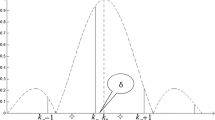Abstract
This paper is concerned with the estimation of the directions-of-arrival (DOA) of multiple linear chirp signals. We construct a novel time-frequency dictionary based on the properties of chirp signals in the fractional Fourier domain, and a sparse reconstruction algorithm is proposed to achieve high performance. Then, the errors resulting from the off-grid model mismatch is considered, and the dictionary matrix is reformulated into a multiplication of a fixed matrix and a sparse matrix. Further, an iterative alternating approach is proposed to improve the accuracy of the DOA estimates. The proposed algorithm provides better estimation, anti-correlation performances and increased resolution than Multiple Signal Classification (MUSIC) and the time–frequency MUSIC (TF-MUSIC) based on the spatial time–frequency distributions. Simulation results demonstrate the effectiveness of the proposed approach.





Similar content being viewed by others
References
A. Belouchrani and M. G. Amin, Time-frequency MUSIC, IEEE Signal Process. Lett., Vol. 6, No. 5, pp. 109–110, 1999.
H. I. Choi and W. J. Williams, Improved time-frequency representation of multicomponent signals using exponential kernels, IEEE Trans. Acoust. Speech Signal Processing, Vol. 37, pp. 862–871, 1989.
C. Clemente and J. J. Soraghan, Range Doppler and chirp scaling processing of synthetic aperture radar data using the fractional Fourier transform, Signal Processing, IET, Vol. 6, No. 5, pp. 503–510, 2012.
S. A. Elgamel and J. J. Soraghan, Using EMD-FrFT filtering to mitigate very high power interference in chirp tracking radars, IEEE Signal Process. Lett., Vol. 18, No. 4, pp. 263–266, 2011.
D. M. Malioutov, M. Cetin and A. S. Willsky, Sparse signal reconstruction perspective for source localization with sensor arrays, IEEE Trans. Signal Processing, Vol. 53, No. 8, pp. 3010–3022, 2005.
A. C. Gurbuz, V. Cevher and J. H. McClellan, Bearing estimation via spatial sparsity using compressive sensing, IEEE Trans. Aerospace and Electronic Systems, Vol. 48, No. 2, pp. 1358–1369, 2012.
Y. J. Chi, L. L. Scharf, A. Pezeshki and A. R. Calderbank, Sensitivity to basis mismatch in compressed sensing, IEEE Trans. Signal Processing, Vol. 59, No. 5, pp. 2182–2195, 2011.
R. Schmidt, Multiple emitter location and signal parameter estimation, IEEE Trans. Antennas and Propagation, Vol. 34, No. 3, pp. 276–280, 1986.
H. M. Ozaktas, M. A. Kutay and D. Mendlovic, Introduction to the fractional fourier transform and its applications, Adv. Imag. Electron. Phys., Vol. 10, No. 6, pp. 239–291, 1999.
L. Qi, R. Tao, S. Y. Zhou, et al., Detection and parameter estimation of multicomponent LFM signal based on the fractional Fourier transform, Sci. China F Inf. Sci., Vol. 47, pp. 184–198, 2004.
J. Yu, L. Zhang and K. Liu, Coherently distributed wideband LFM source localization, IEEE Signal Process. Lett., Vol. 22, No. 4, pp. 504–508, 2015.
P. Tseng, Convergence of a block coordinate descent method for nondifferentiable minimization, Journal of Optimization Theory and Applications, Vol. 109, No. 3, pp. 475–494, 2001.
H. Krim and M. Viberg, Two decades of array signal processing research: the parametric approach, IEEE Signal Process. Mag., Vol. 13, No. 4, pp. 67–94, 1996.
P. Stoica and A. Nehorai, Performance study of conditional and unconditional direction-of arrival estimation, IEEE Trans Acoust. Speech Signal Processing., Vol. 38, pp. 1783–1795, 1990.
Acknowledgements
This work was supported in part by in part by the Scientific Research Foundation of Civil Aviation University of China under Grant 2017QD14X and the National Science Foundation of China under Grant 61501322. We thank the anonymous reviewers for providing helpful comments on earlier drafts of the manuscript.
Author information
Authors and Affiliations
Corresponding author
Additional information
Publisher's Note
Springer Nature remains neutral with regard to jurisdictional claims in published maps and institutional affiliations.
Rights and permissions
About this article
Cite this article
Zhang, L., Hung, CY., Yu, J. et al. Linear Chirp Signal DOA Estimation Using Sparse Time–Frequency Dictionary. Int J Wireless Inf Networks 27, 568–574 (2020). https://doi.org/10.1007/s10776-020-00489-1
Received:
Revised:
Accepted:
Published:
Issue Date:
DOI: https://doi.org/10.1007/s10776-020-00489-1




